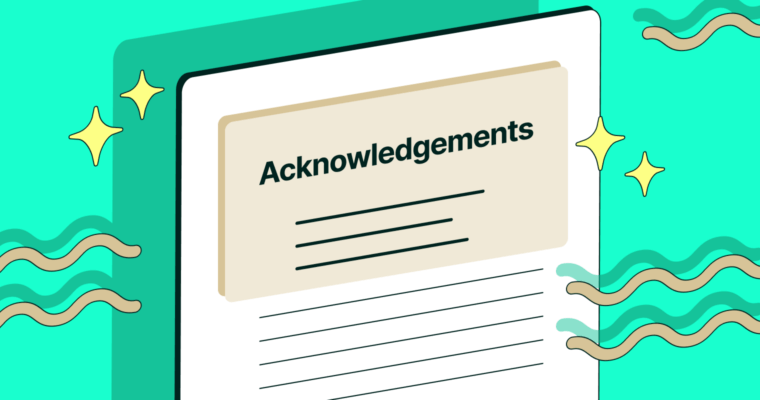
You’re almost there. You’ve finished your research, you’ve written your thesis, you’ve formatted your work and bibliography, and now you can see yourself in a cap and gown, the newly minted holder of a master’s degree or PhD.
You put in the work—but you didn’t get there alone. Like every protagonist in a literary journey, a cast of characters helped you along the way. The place to recognize them is in the acknowledgment section of your thesis. Read on to learn how to write an acknowledgment for a thesis.
What is an acknowledgment for a thesis?
An acknowledgment for a thesis is a short section within the thesis that recognizes the people who supported its author through their work. This includes the author’s colleagues as well as family members and friends.
Although an acknowledgment section is not a required part of a thesis or dissertation, writing one is generally considered to be good etiquette, for a few reasons:
- Although you did the bulk of the work on your thesis, others provided support that made it easier—and in some cases, made it possible—for you to conduct your research and complete your thesis.
- In many cases, the people who supported you are the people you will seek out for collaboration on future projects. Acknowledging their role in supporting you through your thesis is a way to build goodwill and avoid offending anybody by making them feel snubbed.
When should you include an acknowledgment in your thesis
Include an acknowledgment in your thesis if anybody helped you conduct your research. Think holistically about this—while you might have conducted the research completely on your own, it’s likely that a lot of people in your life made the process easier for you in some way. For example, your parents might have contributed to your rent each month so you could focus on your work, or your best friend might have met up with you for late-night vent and movie sessions to bring you back up for air after intense study and writing periods.
The reason why most graduates include an acknowledgment in their thesis is to show their gratitude for the people who helped them through the long, academically challenging process of completing their work. For many, it’s also an investment in the future. The people who helped you on the way to this point will often become your colleagues or collaborators, and remembering them now can earn their goodwill later.
Who should be acknowledged?
Anybody who worked on your thesis with you or otherwise made your life easier during that period should be acknowledged. One easy way to make sure you don’t leave anybody out is to write a list of everybody who played a role in you completing your work, no matter how small their contribution.
Once you’ve got your list, divide it into two categories: professional and personal acknowledgments.
Professional acknowledgments
Professional acknowledgments should include everybody who supported you in a professional capacity, like your adviser, colleagues, lab assistants, research participants, and any individuals or groups who funded your work. For this last category, note how much each funding body contributed and any additional relevant details, like the specific aspects of your work made possible by their contributions. When you write your thesis acknowledgment, this section goes first.
Personal acknowledgements
Personal acknowledgements includes everybody who supported you in a non-professional capacity. Their support is no less important than the first group’s support, but it is quite different. In this section, acknowledge your partner, family, and friends for their motivation and support. This is also the section where you can recognize anybody who inspired you to pursue your research or influenced you.
3 tips for writing an acknowledgment for a thesis
1 Format
An acknowledgment is generally about a page long, though it can be longer or shorter. There’s no strict length limit for acknowledgments; take as much space as necessary to thank everybody whose help and support made your thesis possible. However, this part of your thesis should not go on ad nauseam: Keeping it to one page or less is preferable.
2 Location
A thesis acknowledgment typically comes after the work’s abstract and before its table of contents. However, this isn’t always the case—check to see if your university has specific guidelines for thesis formatting.
3 Tone
Use an appreciative, professional tone. For each professional acknowledgment, include the individual’s full name and title. For personal acknowledgments, avoid nicknames and any sappy or overly sentimental language.
Thesis acknowledgment example
I am deeply indebted to my kind, motivated supervisor, Dr. Andres Gutierrez. From the moment I proposed this project to my thesis defense, he has provided valuable feedback that pushed me to take my work further than I thought it could go.
Many thanks to my colleagues, Andrea Sycho, MA, and Elizabeth Zain. They were the best sounding boards and providers of constructive feedback I could ask for. I truly appreciate every conversation we had and every piece of moral support I received.
Finally, I’d like to thank my family. Mom and Dad, you’ve known this has been my goal since childhood, and you’ve supported me every step of the way. Thank you for always being there for me.
Thesis acknowledgment FAQs
What is it?
A thesis acknowledgment is a brief section within a thesis that recognizes the people who supported the thesis’s author, professionally and personally, as they completed the work.
Who should be acknowledged?
Acknowledge everybody who played a role in the completion of your research, no matter how directly or indirectly involved they were. This includes your supervisors, colleagues, assistants, and funding bodies as well as family and friends who provided moral and material support.
What are some tips for acknowledgments in your thesis?
In a thesis acknowledgment, maintain a professional tone. It doesn’t need to be stuffy or stilted, but it also should not be overly conversational.
List professional acknowledgments before personal acknowledgments. When listing professional collaborators, influences, supervisors, and helpers, list each individual’s full name and title.
Keep the acknowledgment concise. It should not exceed one page.






